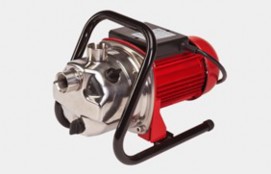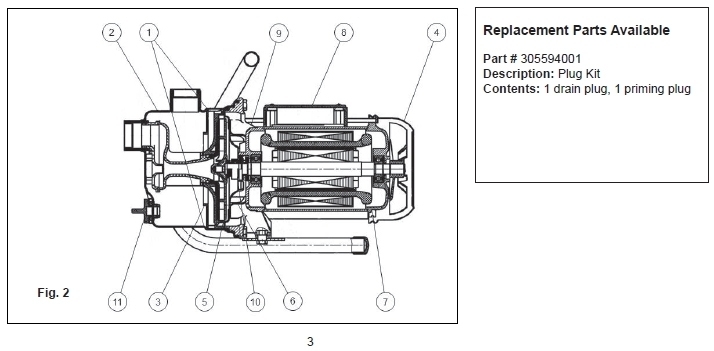
APPLICATIONS
Ideal for pressure boosting, sprinkler systems, and general purposeapplications where portability and corrosion-resistance isimportant.
FEATURES & BENEFITS
|
Recommended Wire Gauge For Electrical Cord Length |
||||||
|---|---|---|---|---|---|---|
|
HP |
Volts |
0-25 ft. |
50 ft. |
100 ft. |
150 ft. |
200 ft. |
|
1/2 |
115 |
14 |
12 |
10 |
8 |
6 |
|
Model |
Item Number |
UPC |
HP |
Amps/Volts |
Cord Length |
Intake |
Discharge |
Discharge Pressure PSI at 5′ Lift |
Max. Flow (GPM) at 5′ Suction Lift |
Max PSI |
Max Head |
||||||
|---|---|---|---|---|---|---|---|---|---|---|---|---|---|---|---|---|---|
|
0 |
10 |
20 |
30 |
40 |
50 |
60 |
|||||||||||
|
Gallons Per Minute |
|||||||||||||||||
|
RJSE-75SS |
614432 |
0 10121 14415 6 |
3/4 |
6.5/115 |
8′ |
1″ |
1″ FNPT |
11 |
9.5 |
9 |
7.3 |
4.6 |
2.3 |
0.4 |
11 |
64 |
147′ |
|
Model |
Length |
Width |
Height |
Weight (lbs) |
Carton Cubes (cu ft) |
Pallet Quantity |
Qty. per Layer |
Layers per Pallet |
|---|---|---|---|---|---|---|---|---|
|
RJSE-75SS |
9.8″ |
15″ |
11.8″ |
21 |
0.69 |
48 |
12 |
4 |
|
Nominal Pipe Size U.S. GPM |
3/4″ |
1″ |
1-1/4” |
1-1/2” |
2” |
|---|---|---|---|---|---|
|
4 |
3.75 |
1.15 |
0.30 |
0.14 |
– |
|
5 |
5.66 |
1.75 |
0.46 |
0.22 |
– |
|
6 |
7.95 |
2.45 |
0.65 |
0.31 |
– |
|
7 |
10.60 |
3.25 |
0.86 |
0.41 |
– |
|
8 |
13.50 |
4.16 |
1.10 |
0.52 |
– |
|
9 |
16.80 |
5.17 |
1.35 |
0.65 |
– |
|
10 |
20.40 |
6.31 |
1.67 |
0.79 |
0.23 |
|
11 |
24.40 |
7.58 |
1.98 |
0.95 |
0.27 |
|
12 |
28.60 |
8.85 |
2.33 |
1.10 |
0.32 |
|
14 |
38.00 |
11.80 |
3.10 |
1.46 |
0.43 |
|
16 |
48.60 |
15.10 |
3.96 |
1.87 |
0.55 |
|
18 |
60.50 |
18.70 |
4.93 |
2.33 |
0.69 |
|
20 |
73.50 |
22.80 |
6.00 |
2.83 |
0.84 |
|
Nominal Pipe Size L/Min. |
20mm |
25mm |
32mm |
40mm |
50mm |
|---|---|---|---|---|---|
|
15 |
3.7 |
1.15 |
0.30 |
0.13 |
– |
|
20 |
5.3 |
1.64 |
0.43 |
0.19 |
– |
|
25 |
7.1 |
2.18 |
0.56 |
0.27 |
– |
|
30 |
13.5 |
4.13 |
1.08 |
0.49 |
– |
|
35 |
16.3 |
5.00 |
1.31 |
0.61 |
– |
|
40 |
23.5 |
7.30 |
1.90 |
0.88 |
0.25 |
|
45 |
28.3 |
8.74 |
2.31 |
1.07 |
0.29 |
|
50 |
34.2 |
10.60 |
2.79 |
1.32 |
0.38 |
|
55 |
40.7 |
12.60 |
3.32 |
1.56 |
0.46 |
|
60 |
48.1 |
14.90 |
3.92 |
1.85 |
0.54 |
|
65 |
55.7 |
17.30 |
4.45 |
2.15 |
0.63 |
|
70 |
63.8 |
19.70 |
5.20 |
2.46 |
0.73 |
|
75 |
72.2 |
22.40 |
5.89 |
2.78 |
0.83 |
